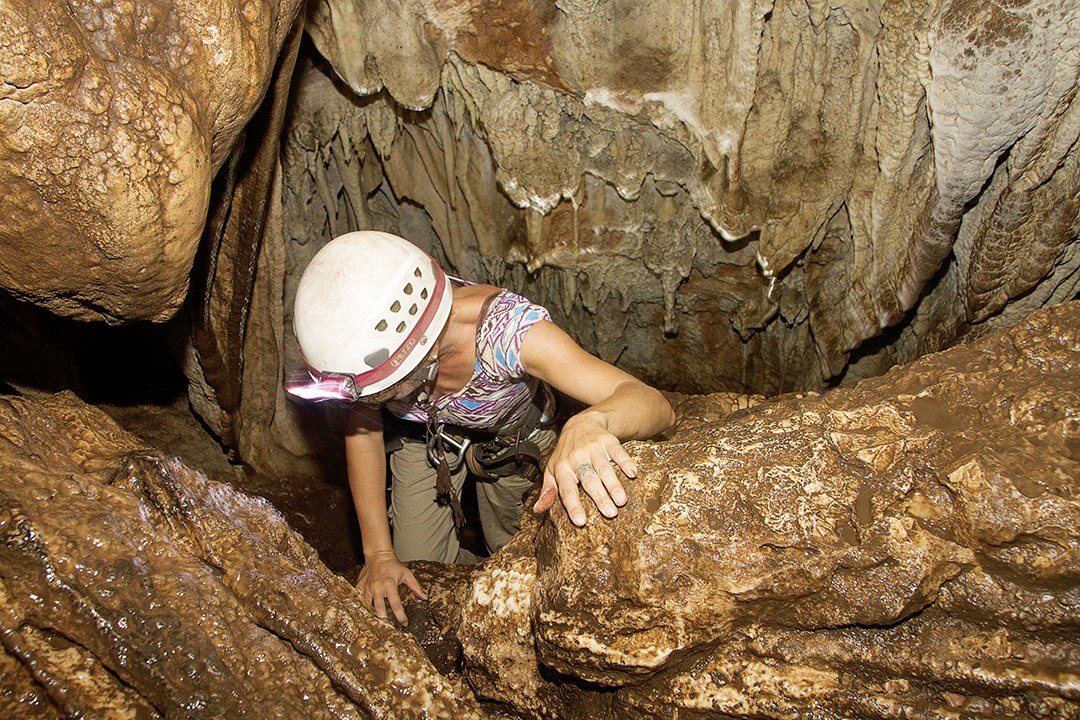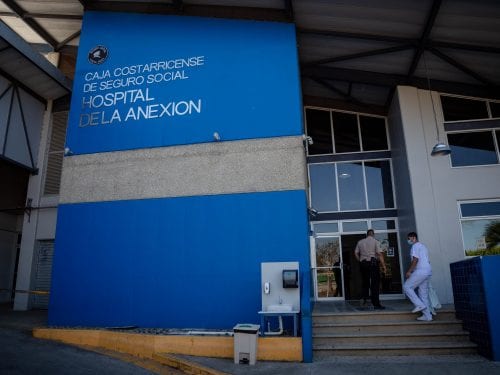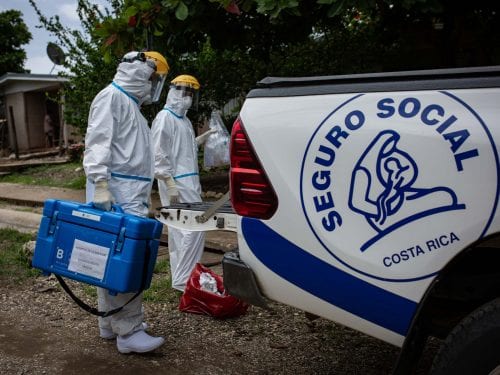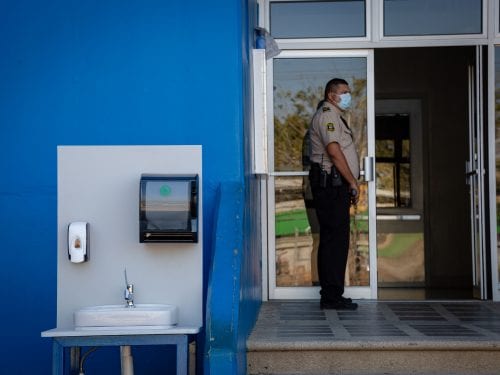
Twenty-two kilometers (about 14 miles) from downtown Nicoya, a hill thousands of years old holds a Chorotega heritage, housing the first traces of Mesoamerican civilizations. What were corals under the sea 60 million years ago are now giant calcified rocks that are just asking to be explored and discovered. Barra Honda National Park opens its gates to transport us to the deepest interior of Guanacaste’s lowlands.
Barra Honda’s hill is a conservation area that was founded in 1974, dedicated to sustaining the threatened Nicoyan dry forest. Inside, the park has at least 36 underground caverns formed millions of years ago, when the lowland that we walk around today was ocean. Half of them still haven’t been fully explored and tourists can only visit two.
The park has an unexplainable magic that attracts everyone who steps on its land. In addition to the caves, it has paths to explore, waterfalls, viewpoints and incalculable biodiversity. Barra Honda is a destination that should not be missed when passing through southern Guanacaste.
With the COVID-19 crisis, this unique land has seen its worst days. The future of Barra Honda is shaky, between the fact that all of the national parks stopped welcoming visitors for five months in 2020 as a result of the health measures due to the pandemic, and that the Legislative Assembly reduced the budget of conservation areas by more than a third.
The park’s economic crisis and the still constant lack of tourists forces its officials to look for alternatives to continue protecting the 2,229 hectares (5,508 acres) of protected area under their charge. The park administrator, Dorian Mendez, said that this is the worst economic crisis the institution has experienced in the last decade.
A Local Hill Hit by the Worldwide Crisis
Mendez said that one of the greatest difficulties is the cut in gasoline for patrolling the area, from the ¢70,000 (about $120 at the time) that the administrator received per month in 2019 to ¢24 thousand (about $39) now, 65.7% less.
The park still needs the same care as before COVID. Wildfires and illegal hunting keep happening. We can’t stop monitoring and leave it unprotected,” stated Mendez.
The crisis also forced the volunteer programs to be shut down, as well as all of the scientific research that was underway in March of 2020. If it wasn’t for the officials, Barra Honda would be left at the mercy of hunters who burn the surrounding lands, affecting the protected areas.
That’s why the officials decided to do patrolling on foot, to manage to cover all of the areas without having to use the gas that they don’t have.
Of course, walking in Barra Honda isn’t an easy thing to do. The hill has hundreds of meters of steep hiking, which tires any experienced explorer at least a little. Officials and guides know these routes like the back of their hands. They traverse them at least once a day.
For the public, the longest path is four kilometers (2.5 miles) each way, leading to the caverns and the Nacaome viewpoint. The patrol routes are much longer and the path is even more difficult. In whatever way they can, the park rangers have to get to the areas that only hunters could get to.
It’s the innovative way we have to do it, faced with such a tough situation,” said Mendez.
A Community that Depends on the Hill
Before Barra Honda was left desolate by COVID-19, the park employed at least eight tour guides and attracted hundreds of guests to hotels and restaurants in and around the area. For months, according to the administrator, all of those people stopped receiving any income at all.
It was very hard to know that the guides were losing their jobs. They weren’t receiving any income. They went from having a normal life, with a very good income, to having nothing to eat,” lamented Mendez.
For the community, those dark days weren’t the end, but rather a new opportunity. Although they had serious financial problems, on the days when the park was closed, they managed to get training and make plans to adapt for when the park reopened its forests.
The guides knew that their work was going to be different from that moment on.
They would have to apply new health protocols, adapt to having limits on the walks they could offer and try to attract Costa Rican tourists, one of their most difficult audiences.
Since mid-July in 2020, the Ministry of Health has allowed tourists to have access to Barra Honda, on the condition that the caverns remain closed. The guides, who were already prepared for those types of measures, began to do guided tours at ¢2,000 (about $3.25) per person to receive some type of income.
On the first day of reopening, the administrator told me, only one guide and two tourists came.
It was the first time that a family from Barra Honda received an income in almost three months. At that time, ¢4,000 meant a pound of rice and a pound of beans that that family didn’t have. Getting to that point made us rethink everything,” Mendez remarked.
“Getting to that point,” according to the coordinator, made the Park, together with the guides, make agreements with businesses in the surrounding communities to sell attractive tours to Costa Rican tourists who wanted to visit the park during the new normal. That idea resulted in Namatours, a small tour operator dedicated to giving people the total experience of entering the magic of Barra Honda.
Now, the guides not only offer tours within the National Park but also sell all-inclusive packages with accommodations, visits to traditional restaurants in the area, Nicoyan tortilla workshops and even Guanacaste folk dance shows.
At the end of 2020, as if it were a Christmas present, the Ministry of Health authorized opening one of the caverns to tourists. At present, although the number of visitors is still very low, the community is healing the deep wounds from the crisis. Tourists can go into the earth’s belly inside the caverns, and the guides can once again think about managing to make a stable living, doing what they love the most.
Today, Barra Honda’s paths are greener than ever. The animals, who got a much-needed break from humans coming and going, are more active than at other times and the species are growing as usual. The forest teems with life and sounds, welcoming those tourists who are inevitably attracted by its extraordinary magnet.
Like its own ecosystem, which was once full of pastures and millions of years ago, was part of the blue ocean, the community that depends on Barra Honda is turning over a new leaf little by little. The road ahead is not easy, but it’s a challenge that its members want and are ready to take on. Barra Honda, once again, is reinventing itself because it’s their only way of living.
What you need to know to get to Barra Honda:
- Admission to Barra Honda costs ¢1,000 + VAT (about $1.65 + tax). The caverns tour costs ¢18,000 (about $30) for nationals and $42 for foreigners, with admission included.
- There are two trails to take. The first route goes to some waterfalls formed by calcified sea rocks toward the west side of the park, which is 2.5 kilometers (1.5 miles) one way and another 2.5 kilometers back. This one is recommended for people who aren’t in good physical condition. The other one goes to the Nacaome viewpoint and is 4 kilometers (2.5 miles) one way and 4 kilometers back. If you don’t want to walk much at all, 200 meters (about 650 feet) from the entrance, there’s a small waterfall where you can spend some time.
- Tours can only be done with a reservation in advance, but due to the rains in 2020, Barra Honda doesn’t have residential Internet or a landline, so you should contact them through WhatsApp: +506 8539-1010 or email: [email protected]
- If you have a 4×4 vehicle, you can avoid the first half of the walk to the caverns, but make sure your vehicle is really capable of going into such precarious terrain since it’s very easy to get stuck.
- To go down into the caverns, you have to go down a small ladder 17 meters (55 feet) high. Before signing up for the caverns, make sure that you’re in good enough physical condition to go down and back up that many meters and that heights don’t cause you to panic while climbing.
- If you want to make a donation for taking care of the park, you can contact the Tempisque Conservation Area: +506 2686-4967 or email: [email protected].







Comments